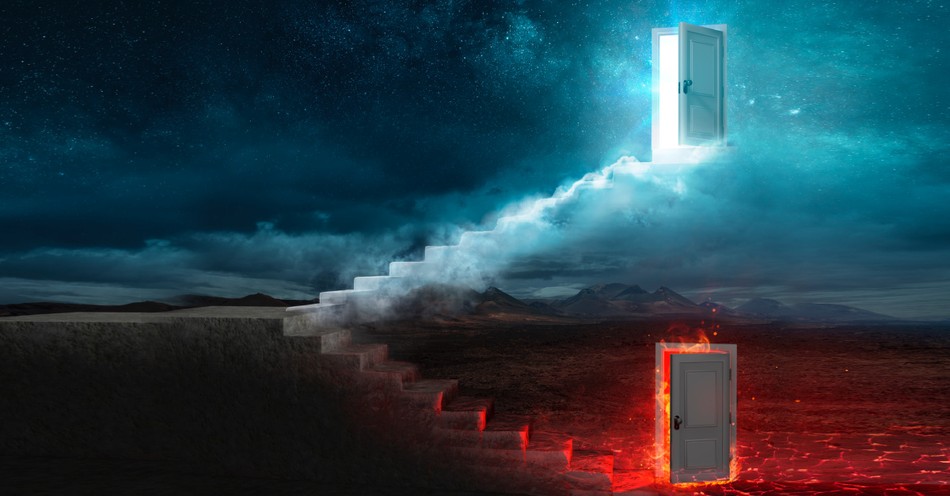Hell quickly becomes an uncomfortable topic in Christianity. In the New Testament, the Bible shares the horrors and terrors of an eternal life separated from God. Perhaps it’s meant to make us uncomfortable. More than simple moral blunders, sin is an eternal thing and therefore has eternal consequences. In his love, God shares revelation about such massive forever destruction to help us avoid it.
And yet the doctrines about hell have come down to the modern day filled with cultural and extra-biblical influences. As societies do, we interpret the idea with our own language and imagery, like medieval flaming caves populated by demons with hooves and pitchforks. Jesus and the disciples also communicated this afterlife of torment with cultural images and meanings.
Biblical Christianity remains connected to previous revelation to a chosen nation, Israel, and the Gospel discussions of hell didn’t arrive in a vacuum. Judaism of two thousand years ago had beliefs about the afterlife, influencing Christianity and even Jews today, which may make us wonder, do Jews believe in hell?
What Did the Jews of Jesus’ Day Believe About Hell?
In Jesus’ day, Jewish religious leaders held different beliefs about hell and the afterlife, particularly the two main schools of Judaism, the Pharisees and Sadducees.
The Pharisees believed in the resurrection of the dead, the existence of angels, and the concept of eternal rewards and punishment for the life lived on earth. All these ideas can be found in the Old Testament, like Daniel 12:2 above. The Pharisees taught that righteous people would rise to everlasting life and the wicked to a forever torment. The Pharisees even used the word Gehenna to describe hell, which Jesus used, as well. Rabbinic literature from the time describes Gehenna as a place of fire and shame, reserved for sinners. Rabbis argued over the time period—some believed the destruction would last a year and others thought it would be eternal.
The Sadducees rejected all of these supernatural beliefs—no resurrection, angels, or afterlife. They focused on the Torah alone and denied anything not clearly taught there. Therefore, they didn’t believe in heaven or hell. For them, death was final with no conscious afterlife.
We get some doctrines of the Essenes from the Dead Sea Scrolls. A more obscure group, the Essenes believed in an afterlife closer to the view of the Pharisees: a “pit of destruction” and “an eternal fire.”
Except for the Sadducees, Jews believed in some form of judgment after death, a painful punishment lasting either a period of time or eternally. Jesus’ teachings aligned more with the Pharisees than any others, although he further highlighted the ideas of unending punishment, calling people to repent to avoid this afterlife. Instead, he called people to an eternal kingdom, also spoken of in the Old Testament, through faith and his work on the cross.
What Do Jews Today Believe About Hell?
For Judaism, the beliefs about hell have continued to develop and change over time.
Influences from Greek thought and apocalyptic literature (like Enoch) expanded the Old Testament doctrine of Sheol and eternal afterlife from Daniel. Medieval Jewish philosophers taught spiritual reward and punishment but not in terms of fire and physical descriptions. They saw the afterlife more as a separation from God or a greater intimacy with him, similar to the New Testament idea.
Traditionally, the Orthodox Jews teach that most souls go to Gehinnom (like Gehenna) after death. Apart from the body, the soul is purified in Gehinnom, similar to a purgatory idea. After the purification period, the soul is cleansed of sins and goes to Olam HaBa, the World to Come. Rabbinic teaching describes Gehinnom as a place of spiritual suffering but not complete torment, showing God’s mercy in a limited duration for most people.
Conservative Judaism moves a bit to the center. It is not strict about the afterlife but does teach about Gehinnom and Olam HaBa. However, it allows for more interpretations of metaphor and symbolism than the literal.
On a more liberal level, Reform and Reconstructionist Judaism mostly reject the idea of any hell, especially literally. They see Gehinnom as purely symbolic for spiritual separation from God now rather than a punishment. Therefore, the Jews in these traditions focus more on the benefits of following God and righteousness in this life, especially on justice and the “healing of the world” (tikkun olam).
As in Christianity, modern Judaism contains a variety of beliefs around hell, from a literal place to symbolism to a dismissal of it entirely.
What Is the New Testament View of Hell?
Jesus spoke about hell more than anyone else in Scripture, which should tell us how loving and important to the message of the Gospel it remains.
Christ taught and used the word Gehenna to describe hell. In his day, the term referred to the Valley of Hinnom outside Jerusalem, where trash and dead bodies burned all the time, a continuous place for the unclean things to be burned and purged from the holy city. The valley even had an evil background as history of child sacrifice to Molech (2 Kings 23:10). For Jesus, this became a perfect symbol for divine judgment. “Do not fear those who kill the body but cannot kill the soul. Rather, fear him who can destroy both soul and body in hell.” (Matthew 10:28) It would have been a horrifying picture for someone to throw a live body into Gehenna. Here, Jesus declares how people should realize God alone has the power to send people to an eternal judgment.
In Mark 9:43-48, Jesus further describes hell as a place “where the worm does not die and the fire is not quenched.” These images refer to an unending decay and torment of fire, supporting an eternal nature of hell. Christ mentions the final judgment in Matthew 25:41, recording what he will say to sinners, the unsaved: “Depart from me, you cursed, into the eternal fire prepared for the devil and his angels.” Jesus teaches how hell was first made for the fallen angels, powerful eternal beings, who rebelled against God’s authority, but humans (made in God’s eternal image) will also be sent there if they also reject the Father. Part of these Gospel teachings on eternal judgment include a radical and painful separation between God and people (“depart from me” language).
The apostolic letters also teach on hell. 2 Thessalonians 1:8-9 cautions how those who “do not obey the gospel of our Lord Jesus” will ultimately “suffer the punishment of eternal destruction, away from the presence of the Lord and from the glory of his might.” Again, we see the combination of everlasting destruction and separation from God’s presence. Hebrews 10:26-27 further describes the “fearful expectation of judgment, and a fury of fire that will consume the adversaries,” or those who choose to reject Christ. Jude 7 connects the eternal fate of the ungodly with Sodom and Gomorrah, people suffering the “punishment of eternal fire.” Revelation points to the idea of hell as the Lake of Fire in several verses: Revelation 14:10-11, 20:14, 21:8), all after a final judgment, consistent with Jesus’ teaching and the apostolic letters.
Thankfully, blessedly, Revelation and the rest of the New Testament offers a second choice, since in his love, God doesn’t want anyone to perish in hell (2 Peter 3:9). While we deserve hell as sinners, God offers an undeserved redemption and renewed future where we can reign with him forever, in relationship and purpose, if we repent unto him by grace and faith.
What Does the Old Testament Say About Hell?
The Old Testament doesn’t present the New Testament doctrine of hell. However, the doctrine of the Law and Prophets includes ideas about the afterlife. They use the Hebrew word Sheol to describe the realm of the dead. This place of death in the afterlife is a dark, silent place where everyone (good and bad) go after death. While some English translations use the word “hell” for Sheol, it’s a different idea in the Old Testament. The Hebrew scriptures don’t describe a place of punishment but a general place of the dead, like an underworld.
When Jacob believes Joseph has died, he says, “I will go down to Sheol to my son, mourning.” The idea has some darkness to it, one of sorrow, just not punishment or terror. In probably the first written book in the Bible, Job begs God, “Oh that you would hide me in Sheol,” (Job 14:13) since he wanted death more than suffering. Again, the realm of death seems more like a dark, sorrowful rest, but not a place of painful torment. Job tried to get release from pain. Psalm 88:3-5 reiterates this perspective.
While the Old Testament doesn’t include painful ideas of consequence, Sheol wasn’t a happy place. The words like “pit” and implications of separation also connect life’s troubles to Sheol.
God’s redemption, then, begins to include avoiding the darkness of Sheol. “Like sheep they are appointed for Sheol … But God will ransom my soul from the power of Sheol, for he will receive me.” This passage (Psalm 49:14-15) shows a different future is possible, one with God forever. Also, the Old Testament would refer to being “gathered to the fathers” after death, meaning the hope to be reunited with God and others after death (especially Abraham, Isaac, and Jacob). These references pointed to more than being in the same burial plot, but a belief in an existence with other believers in a place of peace instead of darkness or a “pit.” God’s covenant would extend beyond life, influencing the New Testament writers.
Daniel influences the New Testament idea of the afterlife as well: “And many of those who sleep in the dust of the earth shall awake, some to everlasting life, and some to shame and everlasting contempt” (Daniel 12:2). Jesus uses similar language and doctrine in his teaching, revealing how the teaching around hell developed over time.
While not all Jews today believe in hell the way Christians understand it, the idea of judgment after death does appear in the Old Testament. Over time, these beliefs became clearer—especially in the teachings of Jesus, who spoke often about eternity. For Christians, it's a reminder that God's Word has always pointed to a real choice beyond this life: everlasting life or everlasting separation from Him.
Peace.
Photo credit: ©Getty Images/Romolo Tavani




